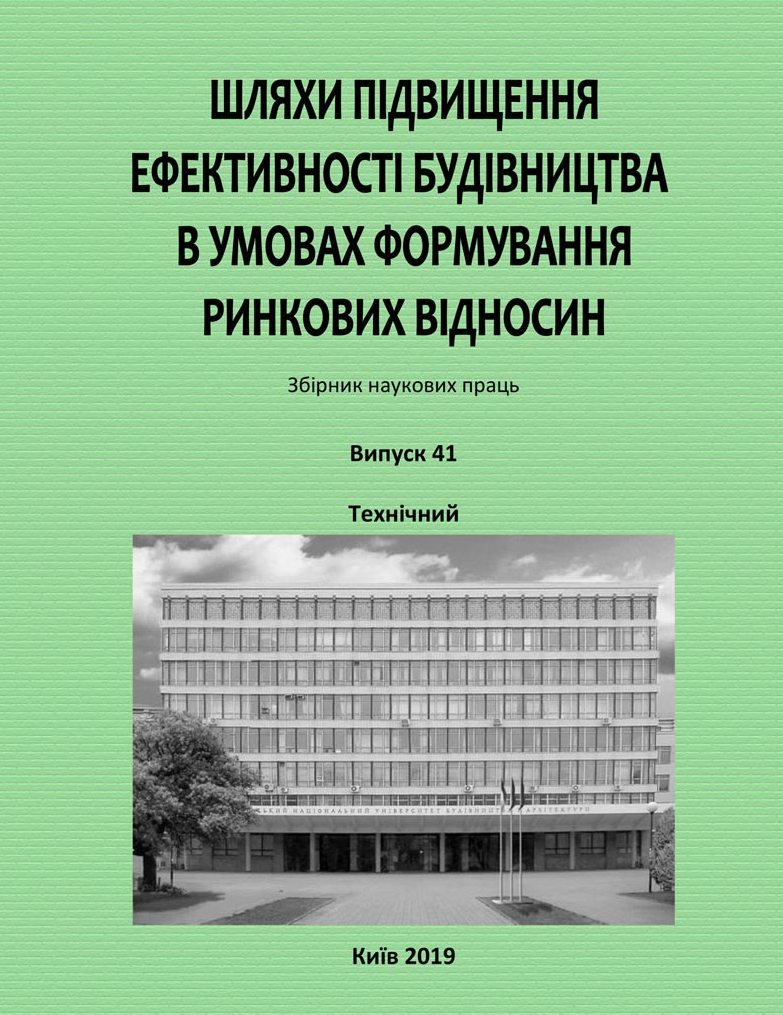Modern wall fencing for energy-efficient frame buildings
DOI:
https://doi.org/10.32347/2707-501x.2019.41.19-28Keywords:
energy efficiency, new generation, block of new trisharovy.Abstract
One of the types of modern fencing structures of multi-storey energy-efficient buildings with external walls, based on floor disks based on the use of a composite wall block with flexible ties, which is a three-layer structure, the bearing layers of which are made of fiberglass concrete, and a heat-insulating layer – from foam glass. The carrier layers are connected by a system of flexible connections made of fiberglass mesh.
To assess the feasibility of using the proposed wall block, a comparison was made of its use and the most frequently used for erecting fencing structures of ASG blocks in the development of a project of a single-entry eighteen-story monolithic residential building based on the project of Gomelgrazhdanproekt OKUP. It was determined that the use of a three-layer wall block with flexible connections can significantly reduce the cost of not only erecting an external fence, but also due to a significant reduction in the volume and mass of load-bearing structures – the cost of the entire building.
The composite wall block was simulated using the ANSYS computer program, which revealed a significant margin in bearing capacity when using the block in the enclosure of buildings with floor-supported floors, which allows it to be used with a slight increase in the thickness of the inner lining (with its development in the supporting zone of the ceiling elements) in low-rise (individual) construction
The proposed three-layer wall block with flexible connections allows you to design wall fencing for energy-efficient buildings with floor-mounted outer walls, which meet all modern regulatory requirements, not only in meeting the required heat engineering properties, but also in providing the necessary corrosion resistance and durability, providing buildings with expressive architectural appearance for the entire period of operation. At the same time, the cost of erection (compared to existing ones) is significantly reduced not only for building envelopes, but also for buildings as a whole, while maintaining all the necessary technical and operational characteristics. In addition, the versatility of its design allows you to use it as a fence on the floor (panel), and with a slight change - as a supporting element for low-rise construction.
References
Derkach, V.N. & Najchuk, A.Ya. (2011). Ob energoeffektivnosti naruzhnogo stenovogo ograzh-deniya karkasnyh zdanij. Arhitektura i stro-itel'stvo. № 1. 22–25.
Gorshkov, A.S. & Vojkov, I.A. (2009). Puti povysheniya energoeffektivnosti ograzhdayushchih konstrukcij zdanij. Sbornik trudov II Vse-rossijskoj konferencii «Stroitel'naya teplofizika i energoeffektivnoe proektirovanie ograzhdayushchih konstrukcij». 45–48.
Orlovich, R.B., Najchuk, A.Ya., Derkach V.N. (2009). Otechestvennye i zarubezhnye tekhnicheskie resheniya po naruzhnomu stenovomu ograzhdeniyu vysotnyh zdanij. Arhitektura, dizajn i stroitel'stvo. 3. 4 [43]. 56–57.
Vasil'ev, A.A. (2011). Novyj material dlya konstrukcij stenovyh ograzhde-nij energoeffektivnyh zdanij. Nauchno-tekhnicheskij zhurnal «Stroitel'naya nauka i tekhnika». 4 (37) 17–20.
Gerashchenko, A.V., Vasil'ev, A.A. (2011). Patent na poleznuyu model' BY 7498 Blok stenovoj trekhslojnyj s gibkimi svyazyami. Opubl. – 19.01.2011.
TKP 45-2.04-43-2006(02250). (2009). Stroitel'naya teplotekhnika. Izmenenie № 1. – Vved. 07.01.2009.
Vasil'ev, A.A., Lapata, M.V. & Gerashchenko, A.V. (2011). Razrabotka stenovyh ograzhdenij s povyshennym ter-micheskim soprotivleniem – osnova energoeffektivnogo stroitel'stva. Vestnik BelGUTa: Nauka i trans-port. – Gomel': BelGUT, 1 (22). 98 – 102.
Vasil'ev, A.A. & Kozunova, O.V. (2017). Raschety na prochnost' kompozicionnyh elementov ograzhdayushchih konstrukcij energoeffektivnyh zdanij variacionno-raznostnym mktodom. Vestnik BelGUTa: Nauka i transport. – Gomel': BelGUT, 2 (35). 56 – 60.
Downloads
How to Cite
Issue
Section
License
Copyright (c) 2020 A. Vasil'ev, O. Kozunova, I. Skripchenko

This work is licensed under a Creative Commons Attribution 4.0 International License.
Authors who publish with this journal agree to the following terms:
- Authors retain copyright and grant the journal right of first publication with the work simultaneously licensed under a Creative Commons Attribution License that allows others to share the work with an acknowledgement of the work's authorship and initial publication in this journal.
- Authors are able to enter into separate, additional contractual arrangements for the non-exclusive distribution of the journal's published version of the work (e.g., post it to an institutional repository or publish it in a book), with an acknowledgement of its initial publication in this journal.
- Authors are permitted and encouraged to post their work online (e.g., in institutional repositories or on their website) prior to and during the submission process, as it can lead to productive exchanges, as well as earlier and greater citation of published work (See The Effect of Open Access).

